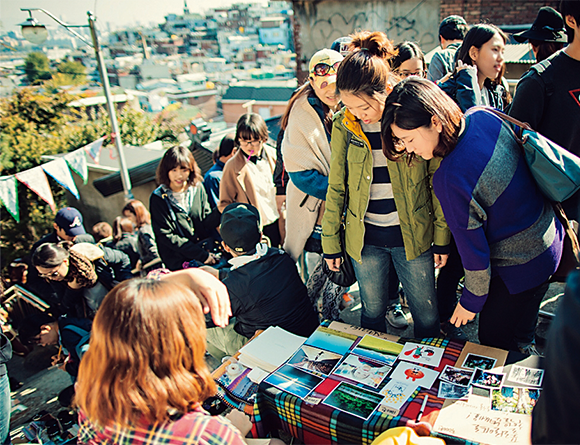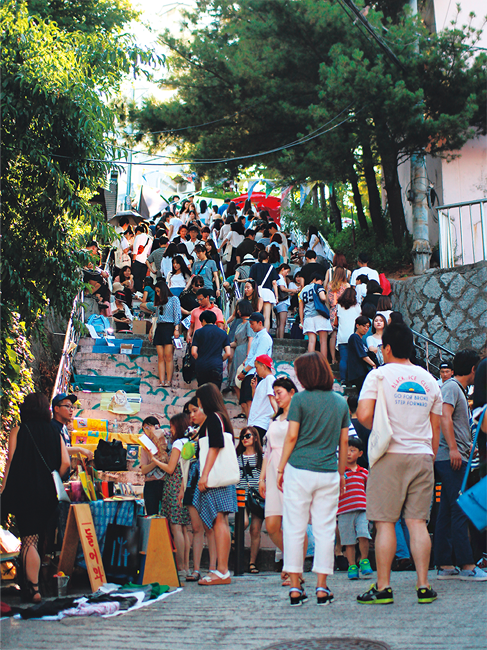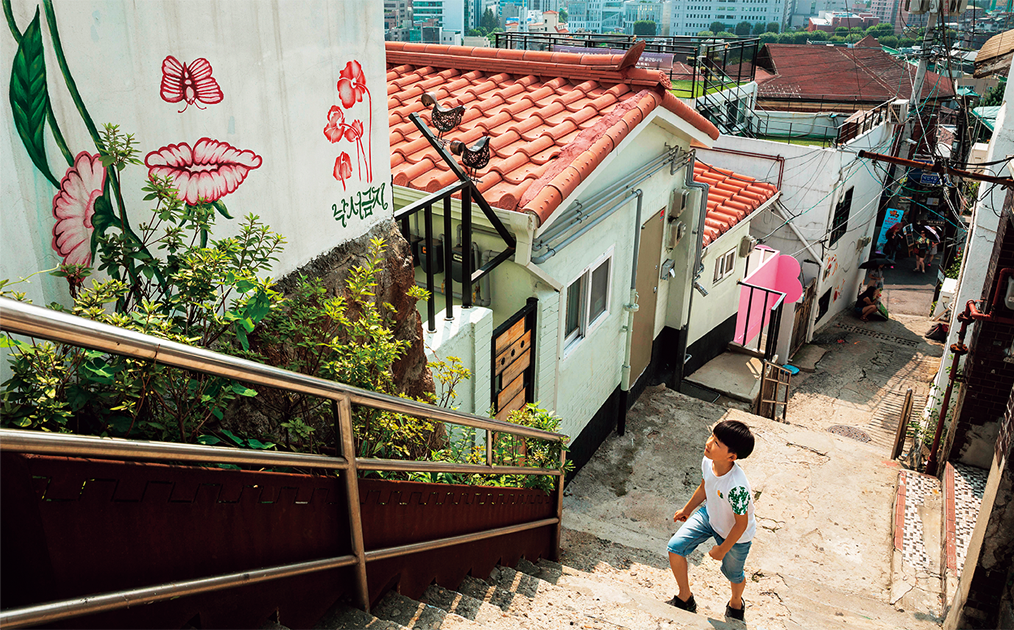Urban regeneration programs launched by the government to revitalizedilapidated neighborhoods through public art projects have d vibrant“mural villages” across the country. But there has been growing discontentamong local residents. They claim that their once quiet neighborhoodshave become playgrounds for the surging number of visitors drawn by theirvillages’ quaint old charms enlivened through the projects.
Making a miraculous recoveryfrom the ruins of war, Seoul hasbecome a cosmopolitan metropoliswith 10 million residents in just 60 years.The Gangnam district, background to Psy’sglobal mega-hit “Gangnam Style,” is theeconomic center of Korea, with numeroushigh-rise buildings lining the streets. It’shard to believe that just 40 years ago, thisaffluent district consisted mainly of farmlandand orchards. In contrast, some placeshave been left behind in the country’s rapidurban development and still retain much oftheir old appearance.
Over 70 percent of Korean territory ismountainous terrain. The capital city ofSeoul is formed around mountains, whichexplains why there are so many stairwaysin the city. Amid rapid modernization andurban development, the poor were steadilypushed out of their neighborhoods andforced to settle in substandard houses inthe hilly areas of the city. People calledthese areas daldongne (literally “moon village”),since their location meant they werecloser to the moon.
The steep stairs leading up to thesehilltop villages speak of the harsh dailylives of the residents. And it is thesestairs that have recently become thecenter of a brewing controversy.
Closure of a Stairway Market

At the stairwaymarket at Usadangilin Itaewon,Seoul, young artistslure passers-bywith the sign, “Capturememories witha polaroid.”
At the entrance to Usadan-gil inItaewon, a district with a unique localculture thanks to its large number offoreign residents, there is a stairwaythat leads to the mosque Seoul CentralMasjid. This was a vibrant neighborhoodbustling with young people drawn to the charming stores with unique productsand restaurants serving traditional cuisines from around the world. But when a market firstopened on this stairway in 2013, things started to change.
The “stairway market” was organized and run by young entrepreneurs and artistsfrom the vicinity. Selling trinkets, fashion accessories, and snacks, the vendors and artiststook part mainly for fun or as an extension of their hobbies, and perhaps to make a smallprofit. As word spread, the stairs soon became packed with people on the last Saturdayof each month, when the market opened. It was fun for both those selling and buying. Butthe market disappeared in March this year. The influx of outsiders had driven up rents andcomplaints had poured in from residents about the inconveniences caused by the market.
The initial hope that the market could transform a decrepit stairway into a local landmarkand bring positive change to the neighborhood ended as only half a success. The stairsbecame a well-known attraction, but this led to a souring of relations among neighbors.
Defacement of Stairway Murals

At the stairwayThe stairway marketthat opened in2013 transformedthe relativelyquiet and pleasantneighborhood intoa bustling attraction,leading toskyrocketing rentalcosts and risingdiscontent amongresidents. Themarket was closedin March this year.
A similar situation occurred in the muralvillage in Ihwa-dong, Jongno-gu. Ihwadongis an area in central Seoul that connectsthe theater district Daehangno andthe 600-year-old city wall meanderingalong the ridge of the mountain behind. Itwas one of the 11 neighborhoods that werechosen for “Art in the City,” the 2006 publicmural project sponsored by the Ministry ofCulture, Sports and Tourism.
Around 70 artists took part in the project,painting murals on the walls of the oldhouses lining the steep hills, installing artworks,and refurbishing street signs. Afterthis moon village, densely packed with rundowntenements and small sweatshopsadjacent to the ancient city wall, received amakeover with attention-grabbing muralson the old houses and stairways, it becamea popular filming location for TV shows anddramas. Soon, people flocked to the village,and it quickly became a popular date spotand tourist attraction. Then, some time ago,residents destroyed the fish and sunflowermurals on the stairways. It was a form ofprotest to bring attention to the noise pollution,littering, and invasion of privacy thatthe residents have had to endure these pastfew years due to the rapid surge in visitors.This shocking incident has developed into alegal dispute.
Visitors vs. Residents
To city folks, places like Usadan-gil andIhwa-dong are rare gems. Open views ofthe city, labyrinthine alleyways and stairs,and small secret spaces tucked away in thecorners offer a refreshing change of sceneryto the uniform, checkerboard streets ofthe modern city. The unpretentious, homelyatmosphere of Ihwa-dong and the simplelives of the residentsthe illusion thattime has stopped there. With the addition of beautiful artworks and publicity from popularTV shows, the village naturally received attention as a charming neighborhood offeringrespite from the hustle and bustle of city life.
But what of the residents? The main purpose of the government’s public initiative was toenable the underprivileged, who often cannot afford the luxury of cultural activities, to enjoyart as part of their daily environment, thereby improving their quality of life and promotingcultural self-esteem. However, the satisfaction of the residents didn’t last that long; it soongave way to rising discontent that crowds of visitors had taken over the staircases and alleywaysthat had once been their playground, hangout, and resting place, completely disruptingtheir neighborhood. The clash of interests between residents wanting to protect theirdaily lives and visitors seeking to enjoy the neighborhood’s charming ambience led to thedrastic defacement of the murals on the stairways. The authorities decided to hold the residentslegally accountable for destroying artworks that had been produced with public funds.So what can be done to address this situation?

Residents of Ihwa MuralVillage are divided betweenthose who thinkthe murals transformedtheir gloomy neighborhoodinto a vibrant placeand those who don’t wanttheir neighborhood tobe a tourist spot but justwant to live in peace.
The crux of the issue is coming up with a program that can satisfy both the visitors andthe local community. Discussions that focus on legal rights are meaningless, since the residentsand the visitors are all citizens with equal rights to use public spaces, such as stairwaysand sidewalks.
Murals first began to appear in Korean cities in the wake of the democratization movementin the 1980s. With the spread of grassroots activism, they were used as a means toexpress political discontent. These murals sparked conflict between the artists and localpeople, but this was short-lived since beautifying the city had not been the primary purpose. In Korea, the origin of murals as pure artworks can be traced back to the neighborhoodstreet exhibitions organized by art students of Hongik University in 1992. With the consentand cooperation of the local community, the students enlivened the dreary walls in theneighborhood with their artworks. This event, which has been ongoing for 24 years now,inspired the government to launch an initiative for cultural urban regeneration.
Ihwa Mural Village is anold neighborhood situatedon a hill under the ancientcity wall of Seoul meanderingalong the ridges ofMt. Nak behind.
Viable Approach to Urban Regeneration
Although these programs are spearheaded by the government, their self-sustenanceand the involvement of residents are of utmost importance for long-term sustainabilityand end results to contribute to restoring humanity in our moderncity. What’s encouraging is that recent projects are applyingorganic approaches to the city and focusing on a citizen-centeredconcept of community. The “comprehensive plan for the urbanrenewal of Seoul,” announced by the Seoul Metropolitan Governmentin 2015, intends to adopt a customized approach to sprucingup neighborhoods, with the local community playing a keyrole from planning to implementation, so as to preserve the individualidentity of each area. The key points of the plan include“customized solutions, spontaneous participation of residents,and creating long-term momentum rather than focusing onimmediate tangible results.”
People walk up and down stairs. Stairs are also where people can sit down to take a rest or standon to take in the view of the city. These basic functions should be taken into account when devisingprograms for these areas.
The controversy surrounding the stairs in Usadan-gil and Ihwa-dong can be approached from thesame perspective. People walk up and downstairs. Stairs are also where people can sitdown to take a rest or stand on to take inthe view of the city. These basic functionsshould be taken into account when devisingprograms for these areas. Also, clearboundaries need to be marked so as to minimizedisputes; the boundaries should beconducive to an enduring sense of harmonyand coexistence. Engaging the local residentsin the project is a prerequisite.
How about creating gardens on thestairways? Skyline gardens, container gardens,rooftop gardens — these are justsome of the many types of gardens that canbe found in cities around the world, whichshow how the beauty of nature can serveas a medium to connect people with urbanspaces. Just the thought of a stairway gardenbeing tended to by the locals brings asmile to my face.
Kwak Hee-sooPrincipal Architect, IDMM Architects
Kim Dong-hyeonPhotographer